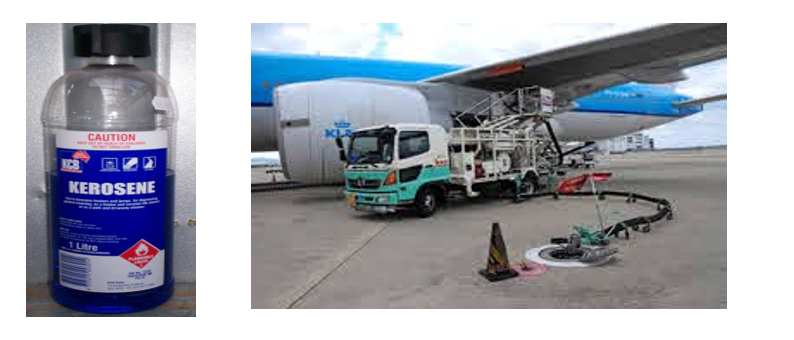Kerosene (petroleum) is a liquid mixture of hydrocarbons whose lighter fractions are refined, mainly into jet fuel, by adding certain additives. Without these additives, which alter its chemical properties, kerosene was and is still used as fuel for oil lamps. Kerosene had its heyday from 1870 until the early 20th century, when it was also referred to as “illuminating oil.” Following the spread of the electric light bulb, kerosene lamps are no longer commonly used in industrialized countries. However, in rural areas in underdeveloped countries kerosene lamps are still often the only available source of light.
Kerosene is widely used to power jet engines of aircraft (jet fuel) and some rocket engines and is also commonly used as a cooking and lighting fuel, and for fire toys such as poi.

Kerosene is also used as a cleaning agent, as it readily dissolves grease and dirt from metal surfaces, and as a component of the fuel used to propel model aeroplanes with diesel engines and jets. Before “winter goods” diesel became available early enough and in adequate volumes, kerosene was often added to diesel, as it improves the flow properties of diesel at low temperatures. Today this method, which was often used for tractors in the agricultural sector, is no longer necessary and can, in fact, harm modern diesel engines.
Petroleum is produced from crude oil using fractional distillation. Like jet fuel, the fuel is a middle distillate. The hydrocarbon molecule chains are between 10 and 16, and compared to jet fuel consist mainly of heavy hydrocarbon molecules. This gives the colorless fuel an average density of approximately 0.8 g/cm3, which is higher than that of many jet fuels and makes petroleum a bit thicker than the aviation fuels, which have been refined with additives. The hydrocarbon mixture is therefore slightly less flammable than gasoline or many jet fuels and has a boiling point at between 175°C to 325°C. The specific energy of petroleum is 43.1 MJ/kg. Kerosene used in lamps should contain as few aromatic compounds as possible, as these play a significant part in producing soot.
The use of the term “petroleum” is ambiguous, especially with regard to the German wording. For example, in English-language articles or books, the term “petroleum products” generally refers to mineral oil or crude oil products in general (see also glossary item “Petroleum & Petroleum Products”). The German product called “Petroleum” only refers to “kerosene” / “kerosine” (US English) or “paraffin oil” (British English) as described above. The German “Kerosin” is generally called “jet fuel” in English and refers mainly to aviation fuel. Therefore, translation errors keep cropping up, even in the technical literature. The word petroleum is a composite of the Latin words “petra” (stone) and “oleum” (oil) and allegedly dates back to an observation by the ancient Romans in Egypt, who observed oil leaking out of the rock in a mountain range in the Gulf of Suez. The economic importance of kerosene that is not refined into jet fuel or other products is low and is continuing to decline.
The term “kerosene” is historically attributed to the Canadian physician, physicist and geologist Abraham Gesner, who produced a highly flammable liquid from coal in Nova Scotia, Canada in 1846. Because a wax-like intermediate was produced during synthesis, Gesner called the liquid kerosene after “keros” the Greek word for wax. In fact, it was petroleum.
